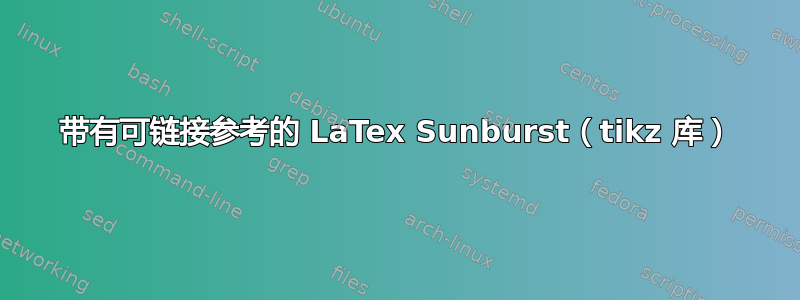
我正在尝试使用这个旭日[关联]一篇科学论文。具体来说,我想在外部框内添加一些参考文献。我成功更新了代码,但是链接的位置有点不对。如下图所示,链接没有遵循曲率。
这是 Latex 文件:
\documentclass{article}
\usepackage[utf8]{inputenc}
\title{Sunburst with References}
\date{}
%%% IMPORT
\usepackage{hyperref} % hyperlinks
\usepackage{url} % simple URL typesetting
\usepackage{graphicx}
\usepackage{xcolor}
\definecolor{orange1}{HTML}{F1753A}
\definecolor{orange2}{HTML}{F7A13E}
\definecolor{orange3}{HTML}{FC6300}
\definecolor{root}{HTML}{B2B2B2}
\usepackage{tikz}
\usepackage{pgfmath}
\usetikzlibrary{decorations.text, arrows.meta,calc,shadows.blur,shadings}
\renewcommand*\familydefault{\sfdefault} % Set font to serif family
% arctext from Andrew code with modifications:
%Variables: 1: ID, 2:Style 3:box height 4: Radious 5:start-angl 6:end-angl 7:text {format along path}
\def\arctext[#1][#2][#3](#4)(#5)(#6)#7{
\draw[
color=white,
thick,
line width=1.3pt,
fill=#2
]
(#5:#4cm+#3) coordinate (above #1) arc (#5:#6:#4cm+#3)
-- (#6:#4) coordinate (right #1) -- (#6:#4cm-#3) coordinate (below right #1)
arc (#6:#5:#4cm-#3) coordinate (below #1)
-- (#5:#4) coordinate (left #1) -- cycle;
\def\a#1{#4cm+#3}
\def\b#1{#4cm-#3}
\path[
decoration={
raise = -0.5ex, % Controls relavite text height position.
text along path,
text = {#7},
text align = center,
},
decorate
]
(#5:#4) arc (#5:#6:#4);
}
\def\arcbase[#1][#2][#3](#4)(#5)(#6)#7{
\draw[
color=#2,
thin,
line width=1.3pt,
% fill=black
]
(#5:#4cm+#3) coordinate (above #1) arc (#5:#6:#4cm+#3)
-- (#6:#4) coordinate (right #1) -- (#6:#4cm-#3) coordinate (below right #1)
arc (#6:#5:#4cm-#3) coordinate (below #1)
-- (#5:#4) coordinate (left #1) -- cycle;
\def\a#1{#4cm+#3}
\def\b#1{#4cm-#3}
\path[
decoration={
raise = -0.5ex, % Controls relavite text height position.
text along path,
text = {#7},
text align = center,
},
decorate
]
(#5:#4) arc (#5:#6:#4);
}
%arcarrow, this is mine, for beerware purpose...
%Function: Draw an arrow from arctex coordinate specific nodes to another
%Arrow start at the start of arctext box and could be shifted to change the position
%to avoid go over another box.
%Var: 1:Start coordinate 2:End coordinate 3:angle to shift from acrtext box
\def\arcarrow[#1](#2)(#3)[#4]{
\draw[thick,-,>=latex,color=#1,line width=1pt,shorten >=-0pt, shorten <=-0pt]
let \p1 = (#2), \p2 = (#3), % To access cartesian coordinates x, and y.
\n1 = {veclen(\x1,\y1)}, % Distance from the origin
\n2 = {veclen(\x2,\y2)}, % Distance from the origin
\n3 = {atan2(\y1,\x1)} % Angle where acrtext starts.
in (\n3-#4: \n1) -- (\n3-#4: \n2); % Draw the arrow.
}
%%%========================================================================
\begin{document}
\maketitle
\section{Chart}
\begin{tikzpicture}[
% Environment Cfg
font=\sf \scriptsize,
% Styles
myarrow/.style={
thick,
-latex,
},
Center/.style ={
circle,
fill=white,
text=root,
align=center,
font =\footnotesize,
inner sep=1pt,
},
]
% Drawing the center
\node[Center](ROOT) at (0,0) {Root \\ Node};
% Drawing the Tex Arcs
% \Arctext[ID][box-style][box-height](radious)(start-angl)(end-angl){|text-styles| Text}
% Node 1:
\arctext[N1][orange1][15pt](1.5)(200)(90){|\footnotesize\bf\color{white}| Node 1};
%Sub 1:
\arctext[N1S1][orange1][13pt](2.5)(120)(90){|\footnotesize\bf\color{white}| Sub1};
\arctext[N1S1S1][orange1][8pt](3.25)(120)(90){|\footnotesize\bf\color{white}| Sub1-Sub1};
%Sub 2:
\arctext[N1S2][orange1][13pt](2.5)(160)(120){|\footnotesize\bf\color{white}| Sub2};
\arctext[N1S2S1][orange1][8pt](4)(170)(140){|\footnotesize\bf\color{white}| Sub2-Sub1};
\arctext[N1S2S2][orange1][8pt](4)(140)(110){|\footnotesize\bf\color{white}| Sub2-Sub2};
%Sub 3:
\arctext[N1S3][orange1][13pt](2.5)(200)(160){|\footnotesize\bf\color{white}| Sub3};
%Node 2:
\arctext[N2][orange2][15pt](1.5)(-90)(90){|\footnotesize\bf\color{white}| Node 2};
%Sub 1:
\arctext[N2S1][orange2][13pt](2.5)(90)(50){|\footnotesize\bf\color{white}| Sub 1};
\arctext[N2S1S1][orange2][8pt](3.25)(90)(60){|\footnotesize\bf\color{white}| Sub3-Sub1};
\arcbase[N2S1S2][orange2][8pt](3.9)(80)(50){|\tiny| {\cite{einstein,dirac,knuth-fa,knuthwebsite}}};
%Sub 2:
\arctext[N2S2][orange2][13pt](2.5)(50)(20){|\footnotesize\bf\color{white}| Sub 2};
\arctext[N2S2S1][orange2][6pt](4.5)(40)(15){|\scriptsize\bf\color{white}| Sub3-Sub1};
\arctext[N2S2S2][orange2][6pt](4.5)(60)(40){|\scriptsize\bf\color{white}| Sub3-Sub2};
%Sub 3:
\arctext[N2S3][orange2][13pt](2.5)(-40)(20){|\footnotesize\bf\color{white}| Sub 3};
\arctext[N2S3S1][orange2][8pt](3.25)(20)(-10){|\footnotesize\bf\color{white}| Sub3-Sub1};
\arctext[N2S3S2][orange2][8pt](3.25)(-40)(-10){|\footnotesize\bf\color{white}| Sub3-Sub2};
%Sub 4:
\arctext[N2S4][orange2][13pt](2.5)(-90)(-40){|\footnotesize\bf\color{white}| Sub 4};
%Node 3:
\arctext[N3][orange3][15pt](1.5)(200)(270){|\footnotesize\bf\color{white}| Node 3};
\arctext[N3S1][orange3][13pt](2.5)(200)(235){|\footnotesize\bf\color{white}| Sub 1};
\arctext[N3S2][orange3][13pt](2.5)(235)(270){|\footnotesize\bf\color{white}| Sub 2};
\arctext[N3S2S1][orange3][8pt](4)(250)(270){|\scriptsize\bf\color{white}| Sub2-Sub1};
\arctext[N3S2S2][orange3][8pt](4)(230)(250){|\scriptsize\bf\color{white}| Sub2-Sub2};
%Drawing the Arrows
%\arcarrow(above/below ID)(abobe/below ID)[shift]
\arcarrow[orange1](below N1S2S2)(above N1S2)[10];
\arcarrow[orange1](below N1S2S1)(above N1S2)[17];
\arcarrow[orange2](below N2S2S1)(above N2S2)[10];
\arcarrow[orange2](below N2S2S2)(above N2S2)[15];
\arcarrow[orange2](below N2S1S2)(above N2S2)[25];
\arcarrow[orange3](below N3S2S1)(above N3S2)[-10];
\arcarrow[orange3](below N3S2S2)(above N3S2)[-10];
\end{tikzpicture}
% \begin{thebibliography}{2}
% \end{thebibliography}
\clearpage
\bibliographystyle{unsrt}
\bibliography{bib} %%% Remove comment to use the external .bib file (using bibtex).
\end{document}
答案1
这轮图我写的包,可以使用。
这是基于包文档中的一个示例。
弧之间的间隙是通过键gap和获得的gap radius。
颜色存储在列表中\WCcolors。
文本由第二个变量给出\WCvarB,并提供给键。此文本的方向取决于键中使用的arc data给出的圆弧中间的角度。此文本位于圆弧的中心。\WCmidanglearc data dirarc data pos=0.5
切片的键fill和overlay在键中设置slices style。如果给出的文本为\WCvarB空,则颜色为none且overlay为true。否则,overlay为false且颜色取决于角度\WCmidangle。
\documentclass[a4paper]{article}
\usepackage{etoolbox}
\usepackage{listofitems}
\usepackage{wheelchart}
\usetikzlibrary{decorations.text}
\usepackage{hyperref}
\begin{document}
\begin{tikzpicture}
\sffamily
\readlist\WCcolors{orange!50,orange!75,orange}
\pgfkeys{
/wheelchart,
arc data=\WCvarB,
arc data dir={\WCmidangle<180?-1:1},
arc data pos=0.5,
arc data style={text color=white},
counterclockwise,
data=,
gap,
gap radius,
slices style={
/utils/exec={
\ifdefempty{\WCvarB}{
\def\WCcolor{none}
\def\WCoverlay{true}
}{
\edef\WCcolor{\WCcolors[\fpeval{\WCmidangle<90?1:(\WCmidangle<210?2:(\WCmidangle<270?3:1))}]}
\def\WCoverlay{false}
}
},
fill=\WCcolor,
overlay=\WCoverlay
}
}
\wheelchart[
middle=Root\\Node,
middle style=darkgray,
radius={1}{2}
]{%
2/Node 1,
1/Node 2,
3/Node 3%
}
\wheelchart[
radius={2}{3}
]{%
4/Sub1,
4/Sub2,
4/Sub3,
3/Sub1,
3/Sub2,
6/Sub1,
6/Sub2,
3/Sub3,
3/Sub4%
}
\wheelchart[
radius={3}{4}
]{%
4/Sub1-Sub1,
20/,
3/Sub2-Sub1,
3/{{\cite{test1}},{\cite{test2}},{\cite{test3}}},
6/%
}
\end{tikzpicture}
\begin{thebibliography}{9}
\bibitem{test1}
\emph{Test 1},
2023.
\bibitem{test2}
\emph{Test 2},
2023.
\bibitem{test3}
\emph{Test 3},
2023.
\end{thebibliography}
\end{document}




